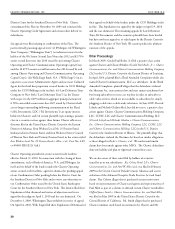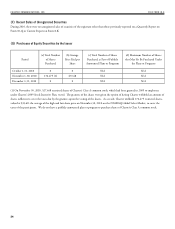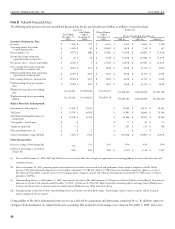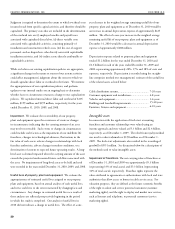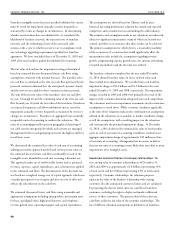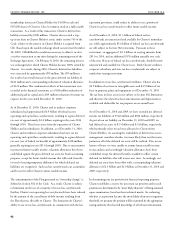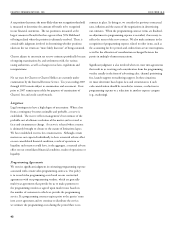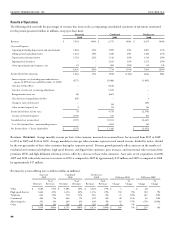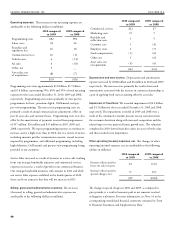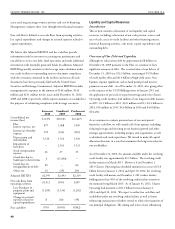Charter 2010 Annual Report Download - page 52
Download and view the complete annual report
Please find page 52 of the 2010 Charter annual report below. You can navigate through the pages in the report by either clicking on the pages listed below, or by using the keyword search tool below to find specific information within the annual report.
Judgment is required to determine the extent to which overhead costs
incurred result from specific capital activities, and therefore should be
capitalized. e primary costs that are included in the determination
of the overhead rate are (i) employee benefits and payroll taxes
associated with capitalized direct labor, (ii) direct variable costs
associated with capitalizable activities, consisting primarily of
installation and construction vehicle costs, (iii) the cost of support
personnel, such as dispatchers, who directly assist with capitalizable
installation activities, and (iv) indirect costs directly attributable to
capitalizable activities.
While we believe our existing capitalization policies are appropriate,
a significant change in the nature or extent of our system activities
could affect management’s judgment about the extent to which we
should capitalize direct labor or overhead in the future. We monitor
the appropriateness of our capitalization policies, and perform
updates to our internal studies on an ongoing basis to determine
whether facts or circumstances warrant a change to our capitalization
policies. We capitalized internal direct labor and overhead of $205
million, $199 million and $199 million, respectively, for the years
ended December 31, 2010, 2009, and 2008.
Impairment. We evaluate the recoverability of our property,
plant and equipment upon the occurrence of events or changes
in circumstances indicating that the carrying amount of an asset
may not be recoverable. Such events or changes in circumstances
could include such factors as the impairment of our indefinite life
franchises, changes in technological advances, fluctuations in the
fair value of such assets, adverse changes in relationships with local
franchise authorities, adverse changes in market conditions, or a
deterioration of current or expected future operating results. A long-
lived asset is deemed impaired when the carrying amount of the asset
exceeds the projected undiscounted future cash flows associated with
the asset. No impairments of long-lived assets to be held and used
were recorded in the years ended December 31, 2010, 2009, and 2008.
Useful lives of property, plant and equipment. We evaluate the
appropriateness of estimated useful lives assigned to our property,
plant and equipment, based on annual analyses of such useful lives,
and revise such lives to the extent warranted by changing facts and
circumstances. Any changes in estimated useful lives as a result of
these analyses are reflected prospectively beginning in the period
in which the study is completed. Our analysis of useful lives in
2010 did not indicate a change in useful lives. e effect of a one-
year decrease in the weighted average remaining useful life of our
property, plant and equipment as of December 31, 2010 would be
an increase in annual depreciation expense of approximately $225
million. e effect of a one-year increase in the weighted average
remaining useful life of our property, plant and equipment as of
December 31, 2010 would be a decrease in annual depreciation
expense of approximately $208 million.
Depreciation expense related to property, plant and equipment
totaled $1.2 billion for the year ended December 31, 2010 and
$1.3 billion for each of the years ended December 31, 2009 and
2008, representing approximately 20%, 17% and 18% of costs and
expenses, respectively. Depreciation is recorded using the straight-
line composite method over management’s estimate of the useful lives
of the related assets as listed below:
Cable distribution systems............................................ 7-20 years
Customer equipment and installations.......................... 4-8 years
Vehicles and equipment................................................ 1-6 years
Buildings and leasehold improvements......................... 15-40 years
Furniture, fixtures and equipment................................ 6-10 years
Intangible assets
In connection with the application of fresh start accounting,
franchises and customer relationships were valued using an
income approach and were valued at $5.3 billion and $2.4 billion,
respectively, as of December 1, 2009. e relief from royalty method
was used to value trademarks at $158 million as of December 1,
2009. e fresh start adjustments also resulted in the recording of
goodwill of $951 million. See discussion below for a description of
the methods used to value intangible assets.
Impairment of franchises. e net carrying value of franchises as
of December 31, 2010 and 2009 was approximately $5.3 billion
(representing 33% of total assets) and $5.3 billion (representing
32% of total assets), respectively. Franchise rights represent the
value attributed to agreements or authorizations with local and state
authorities that allow access to homes in cable service areas. For
valuation purposes, they are defined as the future economic benefits
of the right to solicit and service potential customers (customer
marketing rights), and the right to deploy and market new services,
such as Internet and telephone, to potential customers (service
marketing rights).



